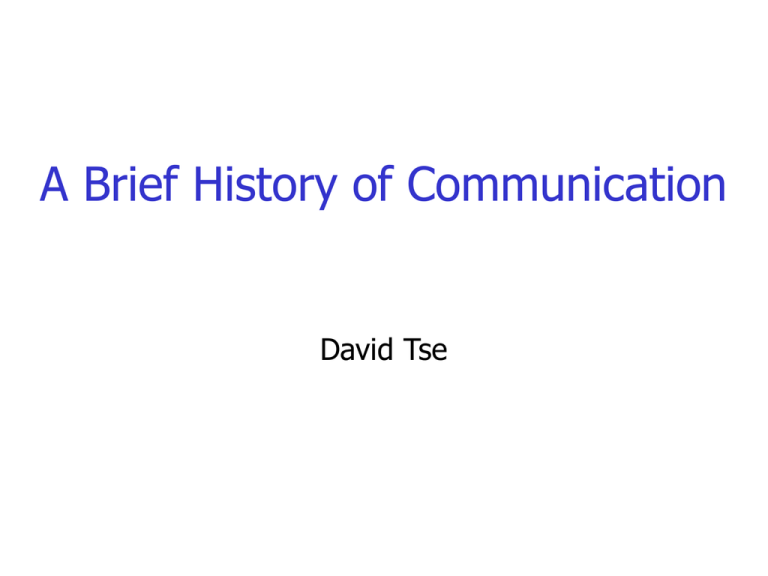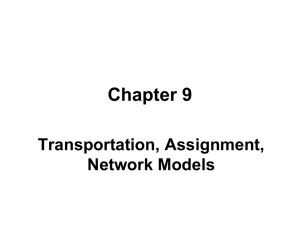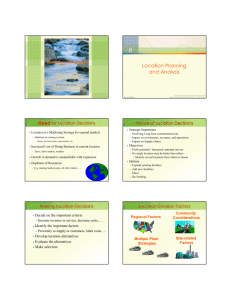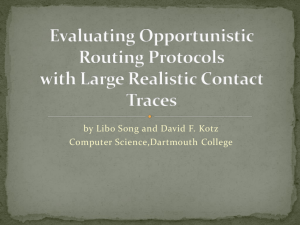A Brief History of Communications
advertisement

A Brief History of Communication David Tse Communication Systems What goes into the engineering of these systems? Key Ingredients • Software • Hardware • Communication architecture, with coding and signal processing algorithms Communication channels can be very nasty! Channel distortion, noise, interference…… How do we communicate reliably over such channels? Communication has a long history • Smoke signals, telegraph, telephone… • 1895: invention of the radio by Marconi • 1901: trans-atlantic communication State of affairs: th Early 20 century • Most communication systems are analog. • Engineering designs are ad-hoc, tailored for each specific application. Big Questions • Is there a general methodology for designing communication systems? • Is there a limit to how fast one can communicate? Harry Nyquist (1928) • Analog signals of bandwidth W can be represented by 2W samples/s • Channels of bandwidth W support transmission of 2W symbols/s From CT to DT Nyquist converted the continuous-time problem to a discrete-time problem. But has he really solved the communication problem? No. You can communicate infinite number of bits in one continuous-valued symbol! Claude Shannon (1948) His information theory addressed all the big questions in a single stroke. Randomness Shannon thought of both information sources and channels as random and used probability models for them. source encoder channel decoder Everything is bits Shannon showed the universality of a digital interface between the source and the channel. source Source Encoder Bit stream Channel encoder channel Information is like fluid • Every source has an entropy rate H bits per second. • Every channel has a capacity C bits per second • Reliable communication is possible if and only if H < C. Simple example: binary symmetric channel C 1 0 1 1-p p p 1-p 0 1 0 0.5 C = 1+ p log p + (1-p) log (1-p) 1 p Initial Reactions Engineers didn’t understand what he was talking about. • People were still stuck in the analog world. • Complexity way too high for implementation technology of the day. • He didn’t really tell people exactly how to design optimal communication systems. 50 years later…. • Our communication infrastructure is going fully digital. • Most modern communication systems are designed according to the principles laid down by Shannon. D Internet S Lessons for Us • Think different • Think big • Think simple Mobility in Embedded Networks People and their stuff Transportation systems (e.g., cars) Inventory and supply chain management (e.g., RFID tags) Environmental and wildlife monitoring (e.g., Princeton ZebraNet Wildlife Tracker) Ubiquitous Mobility • All nodes potentially move – Network topology changes with time • Efficient routes require knowledge of topology – Control traffic: distance vector or link state updates, flooded discovery packets, … Shanno • Scaling to large networks? – How costly is the dissemination of enough information to allow for “reasonably good routes”? – Does control traffic grow more quickly than capacity of the network? Position-based Routing • Position-based routing: – Geographic coordinates rather than graph to make routing decisions • Local routing decisions based on positions of destination and neighbors • Separation into – Location service: where is the destination? – Local routing protocol: select next hop towards destination Bla • Bullet 1 • Bullet – Bullet 2.0 – Bullet 2.1 • Bullet 3 Location Services • Challenge: construct a distributed database out of mobile nodes • Approaches: – Virtual Home Region: hash destination id to geographic region -> rendez-vous point for source and dest (Giordano & Hamdi, EPFL tech. report, 1999) – Grid Location Service: quad-tree hierarchy, proximity in hashed id space (Li et al., Mobicom 2000) – DREAM: Distance Routing Effect Algorithm (Basagni & Chlamtac & Syrotiuk, Mobicom 1998) Last Encounter History • Question: – Do we really need a location service? • Answer: – No (well, at least not always) • Observation: – Only information on network topology available for free at a node is local connectivity to neighboring nodes – But there is more: history of this local connectivity! • Claim: – Collection of last encounter histories at network nodes contain enough information about current topology to efficiently route packets Last Encounter Routing • Can we efficiently route a packet from a source to a destination based only on LE information, in a large network with n nodes? • Assumptions: – Dense encounters: O(n^2) pairs of nodes have encountered each other at least once – Time-scale separation: packet transmission (ms) << topology change (minutes, hours, days) – Memory is cheap (O(n) per node) • Basic idea: – Packet carries with it: location and age of best (most recent) encounter it has seen so far – Routing: packet consults entries for its destination along the way, “zeroes in” on destination Definition: Last Encounter Table encounter at X between A and B at t=10 X A B: loc=X, time=10 C: ... B A: loc=X, time=10 C: ... D: ... Fixed Destination A Moving Destination A A A A A A -T Exponential Age Search (EASE) time 0 source destination ? -T time -T/2 0 EASE: Messenger Nodes EASE: Searching for Messenger Node -T time -T/2 0 Search: who has seen dest at most T/2 secs ago? EASE: Forwarding the Packet time -T -T/2 0 Forwarding towards new position with T:=new encounter age EASE: Sample Route Def: anchor point of age T = pos. of dest. T sec ago src EASE: - ring search nodes until new anchor point of age less dst than T/2 is found - go there and repeat with T=new age Performance of EASE • Length of routes clearly depends on mobility process – Cannot work without locality – Counterexample: i.i.d. node positions every time step • Model: – 2-D lattice, N points, fixed density of nodes – Each node knows its own position – Independent random walks of nodes on lattice • Cost = forwarding cost + search cost Cost of EASE Routes • Claim: – The asymptotic expected cost for large N of EASE routes is on the order of shortest route, i.e., total forwarding cost is O(shortest path): • Forwarding cost: – Geometric series of ages -> geometric series of EASE segments – Total length = O(shortest path) Search Cost • Single step search cost is small compared to forwarding cost: – Show that density of messenger nodes around current anchor point is high – Depends on: • Number of unique messenger nodes encountered by destination = O(log T) • Distance traveled by messenger nodes = same order as destination Interpretation: Distance Effect and Mobility Diffusion destination • Observation: required precision of destination’s location can decrease with distance – DREAM algorithm: exploit distance effect to decrease state maintenance overhead – When a node moves by d meters, inform other nodes in disk of radius c*d meters – Relax separation of location service and routing service • Basic idea behind last encounter routing: – Exploit mobility of other nodes to diffuse estimate of destination’s location “for free” – Concurrently for all nodes Improvement: Greedy EASE Simulation: Random Walk Model •N nodes •Positions i.i.d. •Increments i.i.d. Simulation: Random Walk Model Heterogeneous Speeds: Slow Dest Heterogeneous Speeds: Fast Dest Heterogeneous Speeds Simulation: Pareto Random Walk •N nodes •Positions i.i.d. •Increments i.i.d., heavy-tailed distance distribution Simulation: Random Waypoint •N nodes •Positions i.i.d. •Every node has a waypoint •Moves straight towards waypoint at constant speed •When reached, new waypoint selected uniformly over area Pareto RW and Random Waypoint Related Idea: Last Encounter Flooding • With coordinate system – Last-encounter information: time + place – EASE/GREASE algorithms • Blind, no coordinate system – Last-encounter information: time only – FRESH algorithm: flood to next anchor point – Henri Dubois-Ferrière & MG & Martin Vetterli, MOBIHOC 03 FRESH: Last Encounter Flooding Summary: Last Encounter Routing • Last Encounter Routing uses position information that is diffused for free by node mobility – Last encounter history: noisy view of network topology – Packet successively refines position estimate as it moves towards destination – Mobility creates uncertainty, but also provides the means to diffuse new information • No explicit location service, no transmission overhead to update state! – Only control traffic is local “hello” messages – At least for some classes of node mobility, routes are efficient! – Key ingredients: locality, homogeneity, mixing of trajectories • Rich area for more research: – Prediction – Integration with explicit location services & routing protocols – More realistic mobility models • Ref: MG & Martin Vetterli, IEEE INFOCOM 03








